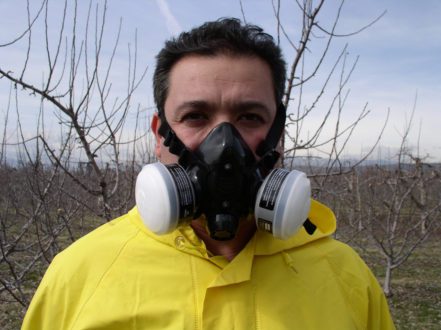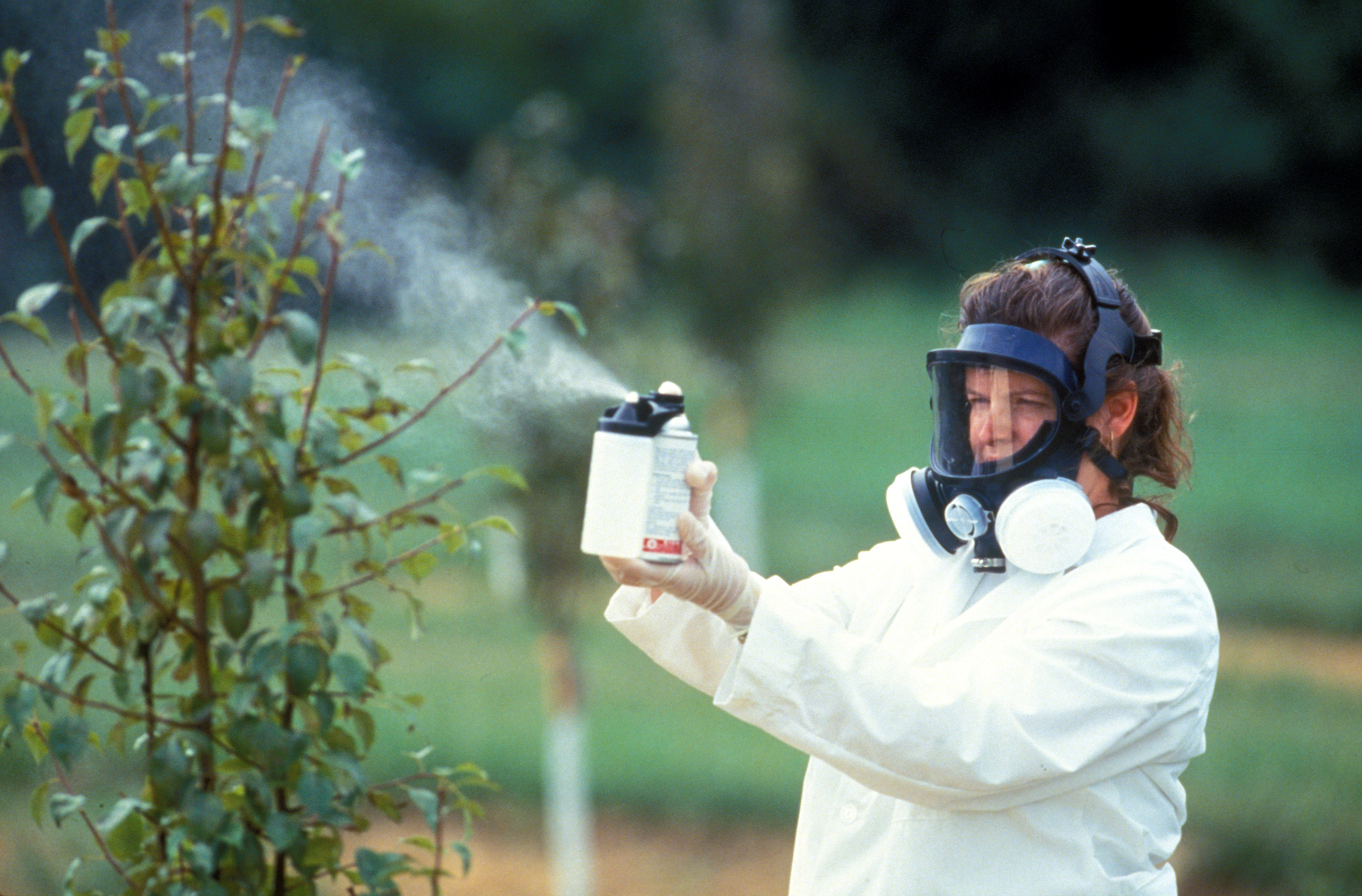

Aug 7, 2018Worker Protection Standard respirator rules updated
Starting in January, growers needed to be compliant with three additional requirements for the updated Worker Protection Standard (WPS).
The new requirements have generated a substantial number of questions from all types of agricultural businesses. Michigan State University Extension will answer some of the most common questions about the updated WPS in this article and also cover the new respirator requirements.
What changed with WPS in January 2018?
As of Jan. 2, 2018, there were three requirements added to the WPS:
- Pesticide safety training must cover the expanded content.
- Pesticide safety information (posters) must meet the revised standards.
- Handlers must suspend applications if workers or bystanders are in the application exclusion zone.
What are the updated posters that employers need? Are the posters free or for sale?
You can download or buy updated posters that are compliant with the new WPS on the Pesticide Educational Resources Collaborative website.
You can also purchase a set of posters along with the Michigan Farm Bureau Agriculture Labor and Safety Services Newsletter (price: $135.99) or the Michigan Farm Bureau/Varnum Manual subscription, which are available separately at $49.95 plus shipping and handling.
What are the changes to the Worker Protection Standard with respect to respirators?
Under the WPS requirements that went into effect in 2017, the employer must “provide the handler with a free medical evaluation, fit testing and respirator training in compliance with the Occupational Safety and Health Administration’s (OSHA’s) Respiratory Protection Standard.” In addition, employers are required to keep records of the medical evaluations, completed fit tests and employee training for a minimum of two years.
What sort of medical evaluation is required for pesticide handlers and applicators according to the new WPS requirements?
The employer must pay for or provide a respiratory medical evaluation for employees who will need to be applying pesticides requiring use of a respirator. In the greenhouse, most pesticide handlers are also applicators. This may not be true in other areas of agriculture. For pesticide applicators, the respiratory medical evaluation needs to occur prior to using the respirator for the first time and if any “significant health changes” occur (e.g., weight gain/loss, new respiratory illness etc.), or if job duties or the working conditions change in ways that put more stress on the wearer (e.g., longer hours in warmer conditions while wearing a respirator).
Employers must identify a licensed health care professional (PLHCP) to do the respiratory medical evaluation to ensure the employee is able to perform duties requiring a respirator. A medical evaluation can also be done online through services such as 3M Online Respirator Medical Evaluation. Occupational medicine clinics across the state provide services such as respiratory medical evaluations and fit testing.
For more information, watch “Medical Evaluations for Workers Who Use Respirators” by OSHA.
How often do people need to obtain a respiratory medical evaluation?
The regulation does not give a timeline in terms of frequency for medical evaluations.
OSHA does not definitively require annual questionnaire completion, and frequency of medical evaluation is determined by four specific circumstances.
According to OSHA’s Respiratory Protection Guide, employees are required to complete questionnaires for initial certification and subsequently only if:
- An employee reports adverse medical signs or symptoms related to wearing the respirator.
- The medical professional determines that medical re-evaluation is necessary.
- Observations made during fit testing suggest the need for medical re-evaluation.
- A change occurs in the workplace conditions.
Although not required by OSHA on an annual basis, questionnaire completion and review is a relatively low-cost, effective way to document employees’ suitability to wear respirators and to potentially identify the need for further medical examination.


What type of respirators are there?
There are six types of respirators according to OSHA. They are listed in the order of increasing protection:
- Single-strap dust masks: Dust masks with only one strap are not National Institute for Occupational Safety and Health (NIOSH) approved but can be useful in filtering out allergens.
- Approved filtering face piece respirators (dust masks): Dust masks with two straps which are NIOSH-approved for particulate matter but do not provide protection against gases or fumes since they do not cover the eyes.
- Half-face respirators: Respirators that cover the nose and mouth, but do not cover the eyes. With correct canisters, they protect the wearer against specified gases and fumes.
- Full-face respirators: Respirators that have a face shield in addition to the coverage over the nose and mouth. With the correct combination of interchangeable filters, they protect the wearer against specified gases and fumes.
- Loose-fitting powered-air-purifying respirators: Respirators that have a full face shield (hood/helmet) and a battery-powered fan and filters that are attached to a belt worn around the waist. The fan pulls the contaminated air through the filter media and then pushes the clean air into the face piece of the hood/helmet. It provides more comfort for the employee (cooling sensation from air movement), eliminates the need to wear safety glasses/goggles, reduces the amount of physical work it takes during breathing to move air through filtration media, and unlike tight-fitting respirators/ dust masks – may be used by those with facial hair.
- Self-contained breathing apparatus: These respirators provide the most coverage and have their own air tank and are commonly used for scuba-diving, fire-fighting, and in outer space.
Are pesticide applicators and handlers required to wear respirators?
Yes, pesticide applicators and handlers are required to wear respirators if the pesticide label calls for them to do so. Therefore, applicators and handlers need to have had a respirator medical evaluation and respirator fit test prior to working with pesticides.
Which pesticides require respirators?
Read and make sure you understand the labels of the pesticides you may use during this growing season. The label of the pesticides will state if a respirator is required and is based on class of pesticide and application method (drench, spray etc.).
Prior to fit testing, what do employees need to do?
All employees who will need or be required to use a respirator as a part of their job will need a respiratory medical evaluation and receive certification that documents the employee is medically able to wear a respirator as a part of their job.
What are the two types of respirator fit-tests?
There are two types of respirator fit tests: qualitative and quantitative. Qualitative fit tests use four OSHA-approved test reagents (sensory agents):
- Isoamyl acetate
- Saccharin
- Bitrex
- An irritant smoke to determine adequate fit (seal) of the chosen respirator.
Qualitative fit tests do not determine the actual amount of leakage into the respirator, but are only based on if the wearer detects a leak as the individual undergoing the fit test will smell or taste the test reagent. For example, if you are fit-tested using isoamyl acetate, which smells like bananas, and you detect that smell, you know your respirator is not fitting properly. Another commonly-used compound for respirator fit-tests is bitrex, a bitter-tasting compound.
Quantitative fit tests measure the actual amount of leakage through the respirator seal and does not rely on your senses of taste or smell as with the qualitative fit testing. It uses a machine for testing. Occupational clinics can perform this type of fit testing.
Either of these fit tests are acceptable for the new WPS.
What are the recordkeeping requirements under WPS?
Employers must keep the following records of the fit testing for a minimum of two years:
- Name of handler tested
- Type of fit test performed
- Make, model, size of respirator tested
- Date of fit test
- Records from respirator medical evaluations
- Results of the fit test (pass or fail for qualitative tests or fit factor, and strip chart recording or other record of the test results for a quantitative fit test)
Annual respirator training recordkeeping includes:
- Name and signature of handler trained
- Date of training
- Trainer’s name
- Training topics
How does facial hair affect respirator fit testing?
Tight-fitting respirators may only be worn by individuals without facial hair (including a single day of growth). Therefore, fit-testing of tight-fitting respirators can only be performed on individuals without facial hair that interferes with the seal of the mask. Individuals with beards, mustaches or other facial hair can wear a tight-fitting respirator if it is trimmed in a way that doesn’t interfere with the mask seal. If the facial hair does interfere with the mask seal, the individual must plan to use a powered-air purifying respirator with a hood. These do not require fit testing, just proper knowledge of how to wear the apparatus.
Where can I get an in-person respiratory medical evaluation prior to respirator fit-testing in Michigan?
Employees can find a local clinic by searching for occupational health clinics in Michigan. You can also see your physician or licensed healthcare professional. You can also find the complete list by county online at the Statewide Occupational Health Clinics and Hospitals list.
– Heidi Lindberg and Jeremy Jubenville, Michigan State University Extension; Melissa Millerick-May, Medicine Division of Occupational and Environmental Medicine; Julie Yocum, Michigan Department of Agriculture and Rural Development.
Top photo: Growers undergoing their annual respirator fit testing at an MSU Extension meeting in January 2018. Photo: Heidi Lindberg, MSU Extension















